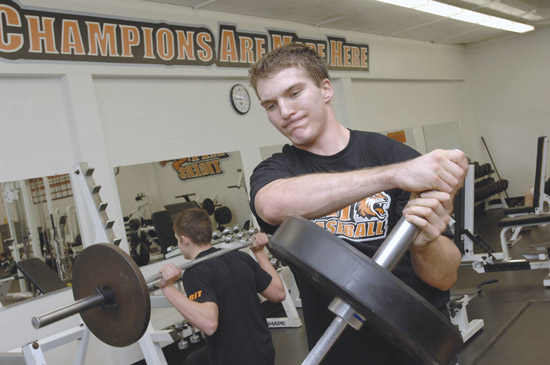For Love of the Game
For student athletes, heart and hard work bring success on the playing field and in the classroom
Baseball player Ryan Tryt starts most days with a 6 a.m. workout, no matter the season.
Ryan Tryt, bundled inside a heavy black coat and a grey winter hat, was taking short, deliberate steps across the ice-coated pavement toward Clark Gymnasium when he spotted his bleary-eyed visitor approaching.
“Welcome to 6 a.m.,” he bellows across the near-vacant parking lot. The sky looks as black as it did when he left campus eight hours ago at the conclusion of his night class.
“I have no distinction of what day it is sometimes,” Tryt says. “It feels like it’s dark all the time.”
Tryt enters the athletics complex and slips into the locker room, emerging a few minutes later wearing a T-shirt and Tiger-orange baseball cap.
It’s time for practice.
Baseball in January may seem incongruous to many (6 a.m. January baseball, no less), but off-season workouts – formal or informal – are a regular occurrence.
In fact, to the 575 student-athletes who participate in RIT’s 24 varsity sports, the term off-season probably seems much stranger.
It’s all a part of the RIT student-athlete experience – an experience, according to Athletic Director Lou Spiotti, that strives to develop the entire person.
“We conduct a competitive intercollegiate athletic program that emphasizes the quality of the athletic experience, along with supporting our student-athletes’ academic goals and personal growth,” Spiotti says. “We spend a lot of time around the development of our student-athletes and provide them with structure so that they can optimize their time here at RIT.”
In turn, the student-athletes spend a lot of their time – in the classroom, in the gym, on the playing field and in the community – working tirelessly to achieve success.
Tryt, a catcher on the baseball team, doesn’t believe there is a secret to that success. Actually, he feels it’s quite simple.
“It’s all about time management,” says Tryt, a fourth-year marketing major. “I tell all of the recruits who come in that it’s not difficult. It’s about making lists of things that need to be done, prioritizing them, and then crossing them off as you do them.”
Tryt should know. He’s excelled both in the classroom and on the baseball diamond – boasting a 4.0 grade-point average and a .364 batting average. Those numbers helped lead to his selection as RIT’s first representative on the College Sports Information Directors of America/ESPN The Magazine Academic All-American Team.
Spiotti says it takes a special type of individual to participate in sports while navigating RIT’s quarter system.
“We have a rigorous portfolio of academic programs at RIT and we also have a very demanding academic calendar,” Spiotti says. “Our student-athletes are special in the fact that they are very focused on their academic lives. In many ways, they are pretty business-like in how they handle their lives. I think they know that, in order to succeed, they have to be business-like.”
There is a lot to do, and little time to do it in.
“I spend, at the very minimum, 25 hours a week playing basketball,” says Joanna Dobeck, a fourth-year electrical engineering major who plays forward on the women’s basketball team. “I spend at least four hours a day practicing, watching film, working out and playing. I try to take one day off a week – usually Sundays.”
Dobeck works just as hard on her studies as she does on her jump shot. And she expected nothing less when she made her college selection.
“I wanted to be challenged academically, that’s why I came to RIT,” she says. “All of the athletes that are recruited pretty much have that mentality as well. We know that we’re going to do well in school as well as on the court.”
And they do.
RIT student athletes consistently outperform the RIT student body at-large in terms of grade-point averages. In the 2006-2007 academic year, RIT student athletes averaged 3.19 grade-point averages. RIT’s overall grade-point average was 3.05.
Spiotti attributes that success to a number of factors. Effective time management skills and academic eligibility requirements are two of them. Others aren’t quite as obvious.
“There is a natural competition among student-athletes to rise above what everyone else is doing. They live in a competitive environment,” Spiotti says. “There is also a safety net in place for each of them. Our student-athletes have coaches and support staff that are really focused on what they’re doing academically.”
Adrienne Gagnier, a fourth-year illustration major who runs track and cross-country, believes the mentality that makes her a successful athlete helps her academically.
“You always work to do your best in a race and you always work to do your best on a project. I feel those two really coincide,” says Gagnier. “I don’t ever want to hand in a project that I didn’t put a lot of time in on, or that I know isn’t good. I hate doing that. I don’t want to do that. Just like I hate going into a race knowing that I didn’t practice hard that week.”
But Dobeck says there is another responsibility that RIT student-athletes take seriously: serving as a role model.
“Once you get immersed in the culture of RIT as an athlete, there’s this expectation that you’re supposed to set an example for everyone else,” Dobeck says. “I take that to heart – especially when it comes to underclassmen.”
In 2007, RIT’s Student Athlete Advisory Committee organized a weekend-long community service project entitled “Tigers Give Back.” More than 350 student athletes participated in a series of service projects around Greater Rochester.
Tryt, a member of the Student Athlete Advisory Committee, says one of the group’s goals is to change the stereotypical perception that many still have about “jocks.”
“Some people think that athletes don’t work hard, that we’re lazy, that we’re going to miss class and get in trouble. That’s just not true,” Tryt says in between greeting his teammates as they arrive for practice.
“We understand that we’re looking for a culture shift. It’s not going to happen overnight. We’re going to have to keep working.”














